Cavernous thrombosis is a rare yet life-threatening medical condition that occurs when a blood clot forms in the cavernous sinus, a large vein located at the base of the brain. This condition typically results from the spread of an infection, most commonly from the face or sinuses, and rapidly becomes a critical emergency due to its location and the structures involved. The cavernous sinus contains vital nerves and blood vessels, and any blockage or inflammation in this area can lead to severe complications, including blindness, paralysis, and even death. Though rare, awareness about cavernous thrombosis is crucial because timely medical intervention can drastically improve outcomes.
Anatomy and Function of the Cavernous Sinus
The cavernous sinus is a complex venous channel situated on either side of the pituitary gland and behind the eyes. It serves as a collection point for blood draining from the face and brain and plays a vital role in regulating intracranial blood flow. Within this structure lie essential cranial nerves (III, IV, V1, V2, and VI), which control eye movement and facial sensation, as well as the internal carotid artery, a major blood supplier to the brain. Because of this dense concentration of vital structures, any disruption—like a clot—in the cavernous sinus can have widespread and catastrophic neurological effects.
What Causes Cavernous Thrombosis?
The primary cause of cavernous thrombosis is infection, especially bacterial infections that begin in the face, nose, or sinuses. Sinusitis, particularly when left untreated or inadequately managed, is the most frequent source. Facial infections such as boils, pimples, or cellulitis in the “danger triangle” of the face (the area between the eyes and upper lip) are also known to spread through facial veins directly into the cavernous sinus due to the absence of valves in these veins. Other causes can include trauma, dental abscesses, or complications from surgical procedures around the head and face. Occasionally, hypercoagulable states—conditions where the blood clots more easily—such as those seen in certain genetic disorders, pregnancy, or cancer, may also contribute to the formation of a thrombus in the cavernous sinus.
How Does Cavernous Thrombosis Develop?
Cavernous thrombosis develops when bacteria or other infectious agents travel through the facial veins and reach the cavernous sinus, triggering the formation of a clot. As the clot grows, it obstructs blood flow and leads to increased pressure within the sinus. This pressure can compress nearby cranial nerves, resulting in symptoms like double vision, eye pain, and facial numbness. The inflammation also spreads to surrounding tissues, worsening the condition and often making symptoms appear suddenly and dramatically. The body’s immune response further contributes to the swelling and deterioration of nerve function in the affected area.
Who Is at Risk of Cavernous Thrombosis?
Certain individuals are more susceptible to developing cavernous thrombosis. Those with chronic sinus or facial infections are at a heightened risk, especially if infections are left untreated. People with compromised immune systems—such as those undergoing chemotherapy, living with HIV, or on long-term steroid therapy—are also at greater risk. Poor hygiene, especially dental hygiene, increases the risk of infections that can lead to cavernous thrombosis. Additionally, individuals with blood clotting disorders, either inherited or acquired, are predisposed to forming abnormal clots, making them more vulnerable to this condition.
Recognizing the Symptoms of Cavernous Thrombosis
The symptoms of cavernous thrombosis typically develop rapidly and can be intensely severe. The most common signs include a sudden, severe headache that doesn’t respond to typical pain medications, swelling around the eyes, and bulging of the eyeballs (proptosis). Eye movement abnormalities and double vision are frequently reported due to the involvement of cranial nerves that control ocular muscles. Patients may also experience facial pain or numbness, fever, nausea, and altered mental status. In advanced cases, seizures, decreased levels of consciousness, and even coma may occur, particularly if the infection spreads to other parts of the brain.
Possible Complications of Cavernous Thrombosis
Cavernous thrombosis, if not treated promptly, can lead to devastating complications. One of the most feared is permanent vision loss, due to damage to the optic nerve or retinal blood supply. Paralysis of the muscles controlling eye movements can also occur, resulting in permanent double vision or a drooping eyelid. If the infection spreads, it may cause meningitis, brain abscesses, or stroke. In the most severe cases, the condition can lead to systemic sepsis or death. The aggressive nature of this condition is why it is considered a medical emergency, requiring immediate hospitalization and treatment.
Diagnosing Cavernous Thrombosis
Diagnosing cavernous thrombosis begins with a thorough clinical examination. The constellation of symptoms—particularly those involving the eyes and face—can raise red flags for clinicians. Imaging tests are essential for confirming the diagnosis. Magnetic Resonance Imaging (MRI) and Magnetic Resonance Venography (MRV) are considered the gold standard because they offer detailed images of soft tissues and blood flow within the venous system. A Computed Tomography (CT) scan may also be used, especially in emergency settings. Blood cultures and inflammatory markers help identify the causative organism and assess the severity of the infection, guiding the choice of antibiotics.
Treatment and Management Strategies
Treating cavernous thrombosis is a multi-pronged effort. The primary goal is to eliminate the infection and prevent the clot from expanding. High-dose intravenous antibiotics are administered as soon as the condition is suspected, even before the specific bacteria are identified. Broad-spectrum antibiotics are used initially, and then narrowed down once lab results are available. In some cases, anticoagulants (blood thinners) are used to prevent the clot from growing or to help dissolve it, though their use remains somewhat controversial and is assessed on a case-by-case basis. Corticosteroids may be used to reduce inflammation and swelling. In severe cases where an abscess forms or there’s a need to relieve pressure, surgical intervention may be necessary to drain infected areas.
Recovery and Prognosis
The prognosis for cavernous thrombosis has improved significantly with the advent of modern antibiotics and imaging techniques. If diagnosed and treated early, many patients make a full recovery. However, the recovery process can be prolonged, and some individuals may experience long-term complications such as partial vision loss, chronic headaches, or cranial nerve damage. Physical therapy and rehabilitation may be required for those who experience neurological impairments. Close follow-up with healthcare providers is crucial to monitor healing and prevent recurrence.
Preventing Cavernous Thrombosis
Prevention hinges on promptly treating facial and sinus infections before they have a chance to spread. This includes not neglecting seemingly minor conditions like pimples, dental abscesses, or mild sinus congestion. Maintaining good hygiene, especially facial and oral hygiene, is essential. Individuals with recurrent sinus infections should be closely monitored and may benefit from ENT (ear, nose, and throat) specialist care. Boosting the immune system through proper nutrition, exercise, and avoiding immunosuppressive behaviors like smoking can also reduce overall risk.
When to Seek Medical Attention
Knowing when to see a doctor can make all the difference. If you or someone you know experiences sudden eye swelling, facial pain, vision changes, or confusion—especially in the context of a recent infection—emergency care should be sought immediately. These are not symptoms to take lightly, as delays in treatment can lead to irreversible damage or even death. Parents should also be vigilant about similar symptoms in children, as they are particularly vulnerable to complications from sinus and ear infections.
Living with a History of Cavernous Thrombosis
For those who have survived cavernous thrombosis, lifestyle changes may be necessary to prevent recurrence or manage lasting symptoms. Regular follow-ups with neurologists and infectious disease specialists can help track recovery progress. Preventive care becomes a top priority, and individuals are often advised to avoid environments that increase infection risks. Long-term anticoagulant therapy may be required in some cases, and managing underlying conditions like diabetes or immune disorders is key to maintaining health.
Clearing Up Misconceptions
There are many myths surrounding cavernous thrombosis. A common misconception is that it’s always fatal—while it can be deadly, many people recover fully with prompt treatment. Another myth is that it only affects older adults; in reality, children and young adults with untreated infections are also at significant risk. Some confuse cavernous thrombosis with a stroke, but while both involve the brain, their causes and manifestations differ significantly. Education and awareness are vital to dispelling these myths and promoting quicker diagnoses.
Conclusion
Cavernous thrombosis is a serious medical condition that demands immediate attention. Although rare, its sudden onset and potential for severe complications make it critical to understand the warning signs and seek urgent care. From recognizing initial symptoms to managing recovery, knowledge truly is power. Timely diagnosis and aggressive treatment can save lives and reduce long-term consequences. Maintaining good hygiene, treating infections early, and staying informed are all part of safeguarding yourself and your loved ones against this potentially life-threatening condition.




